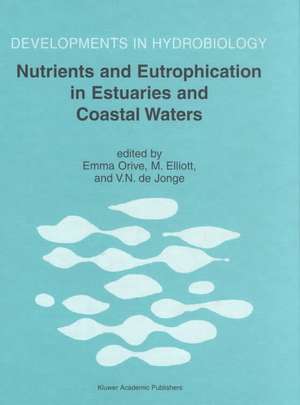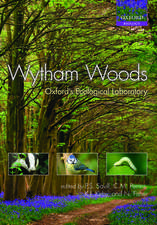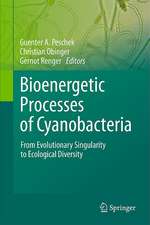Nutrients and Eutrophication in Estuaries and Coastal Waters: Developments in Hydrobiology, cartea 164
Editat de Emma Orive, M. Elliott, Victor N. de Jongeen Limba Engleză Hardback – 31 oct 2002
The book provides many examples of the effects of the enhanced supply of nutrients and organic matter on the chemical features of the water and on the structure, metabolism and trophic pathways of the biological communities.
Also included are several case studies providing considerable insight into the response of the different coastal ecosystems to long term changes in the trophic state of the water.
Current knowledge on modeling as a tool to manage the trophic state of the coastal ecosystems is also dealt with, making this book one of interests to scientist and students as well as managers.
| Toate formatele și edițiile | Preț | Express |
|---|---|---|
| Paperback (1) | 1243.92 lei 6-8 săpt. | |
| SPRINGER NETHERLANDS – 28 oct 2010 | 1243.92 lei 6-8 săpt. | |
| Hardback (1) | 1252.30 lei 6-8 săpt. | |
| SPRINGER NETHERLANDS – 31 oct 2002 | 1252.30 lei 6-8 săpt. |
Din seria Developments in Hydrobiology
- 18%
 Preț: 1229.10 lei
Preț: 1229.10 lei - 18%
 Preț: 959.98 lei
Preț: 959.98 lei - 18%
 Preț: 963.91 lei
Preț: 963.91 lei - 15%
 Preț: 648.24 lei
Preț: 648.24 lei - 15%
 Preț: 637.89 lei
Preț: 637.89 lei -
 Preț: 378.25 lei
Preț: 378.25 lei - 15%
 Preț: 644.95 lei
Preț: 644.95 lei - 18%
 Preț: 952.09 lei
Preț: 952.09 lei - 20%
 Preț: 558.87 lei
Preț: 558.87 lei - 18%
 Preț: 1833.65 lei
Preț: 1833.65 lei -
 Preț: 393.59 lei
Preț: 393.59 lei -
 Preț: 406.54 lei
Preț: 406.54 lei - 18%
 Preț: 1226.73 lei
Preț: 1226.73 lei - 18%
 Preț: 956.99 lei
Preț: 956.99 lei -
 Preț: 388.87 lei
Preț: 388.87 lei - 24%
 Preț: 1060.53 lei
Preț: 1060.53 lei - 18%
 Preț: 1229.28 lei
Preț: 1229.28 lei - 20%
 Preț: 569.31 lei
Preț: 569.31 lei -
 Preț: 368.79 lei
Preț: 368.79 lei - 24%
 Preț: 817.48 lei
Preț: 817.48 lei - 18%
 Preț: 958.25 lei
Preț: 958.25 lei - 18%
 Preț: 953.03 lei
Preț: 953.03 lei -
 Preț: 384.75 lei
Preț: 384.75 lei - 24%
 Preț: 1582.95 lei
Preț: 1582.95 lei - 24%
 Preț: 1051.70 lei
Preț: 1051.70 lei - 18%
 Preț: 943.57 lei
Preț: 943.57 lei - 18%
 Preț: 1235.76 lei
Preț: 1235.76 lei - 24%
 Preț: 800.05 lei
Preț: 800.05 lei - 24%
 Preț: 803.57 lei
Preț: 803.57 lei - 18%
 Preț: 948.29 lei
Preț: 948.29 lei
Preț: 1252.30 lei
Preț vechi: 1527.19 lei
-18% Nou
Puncte Express: 1878
Preț estimativ în valută:
239.63€ • 261.11$ • 201.92£
239.63€ • 261.11$ • 201.92£
Carte tipărită la comandă
Livrare economică 23 aprilie-07 mai
Preluare comenzi: 021 569.72.76
Specificații
ISBN-13: 9781402008702
ISBN-10: 1402008708
Pagini: 536
Ilustrații: X, 526 p.
Dimensiuni: 203 x 276 x 34 mm
Greutate: 1.44 kg
Ediția:2002
Editura: SPRINGER NETHERLANDS
Colecția Springer
Seria Developments in Hydrobiology
Locul publicării:Dordrecht, Netherlands
ISBN-10: 1402008708
Pagini: 536
Ilustrații: X, 526 p.
Dimensiuni: 203 x 276 x 34 mm
Greutate: 1.44 kg
Ediția:2002
Editura: SPRINGER NETHERLANDS
Colecția Springer
Seria Developments in Hydrobiology
Locul publicării:Dordrecht, Netherlands
Public țintă
ResearchCuprins
Preface. The Estuarine and coastal Sciences Association (ECSA). Introductory paper. Causes, historical development, effects and future challenges of a common environmental problem: eutrophication; V.N. de Jonge, et al. Hydrodynamic control of chemical and biological processes. Modern foraminiferal record of alternating open and restricted environmental conditions in the Santo André lagoon, S.W. Portugal; A. Cearreta, et al. Nutrient inputs to the Irish Sea: temporal and spatial perspectives; K. Kennington, et al. Nutrient-enhanced productivity in the northern Gulf of Mexico: past, present and future; N.N. Rabalais, et al. Potential modification of the fluxes of nitrogen from the Humber estuary catchment (UK) to the North Sea in response to changing agricultural inputs and climate patterns; A.D. Tappin, et al. Methods and approaches to assess and control estuarine and coastal eutrophication. Estimation of ecological energy using weighing parameters determined from DNA contents of organisms - A case study; J.C. Fonseca, et al. Trophic status based on nutrient concentration scales and primary producers community of tropical coastal lagoons influenced by groundwater discharges; J.A. Herrera-Silveira, et al. 'Ferry-Boxes' and data stations for the improved monitoring and resolution of eutrophication related processes: application in Southampton Water UK, a temperate latitude hypernutrified estuary; S.E. Holley, D.J. Hydes. Identifying 'hot spots' of biological and anthropogenic activity in two Irish estuaries using means and frequencies; M.P. Johnson, et al. Distribution patterns of nutrients and symptoms of eutrophication in the Rio de la Plata River Estuary System; G.J. Nagy, et al. Baseline study of soft bottom benthic assemblages in the Bay of Santander (Gulfof Biscay);A. Puente, et al. Chemical fluxes between and within ecosystems. Nutrient (N, P, Si) fluxes between marine sediments and water column in coastal and open Adriatic; A. Baric, et al. Nitrogen fluxes and budget seasonality in the Ria Vigo (NW Iberian Peninsula); R. Prego. The winter and summer partitioning of dissolved nitrogen and phosphorus. Observations across the Irish Sea during 1997 en 1998; T.M. Shammon, R.G. Hartnoll. Long-term changes in Wadden Sea nutrient cycles: importance of organic matter import from the North Sea; J.E.E. van Beusekom, V.N. de Jonge. Particulate inputs to Dublin Bay and to the South Lagoon, Bull Island; J.G. Wilson, et al. Modelling of estuaries and coastal waters. A model for predicting the temporal evolution of dissolved oxygen concentration in shallow estuaries; A. García, et al. Modelling the faecal coliform concentrations in the Bilbao estuary; J.M. García-Barcina, et al. Simulating vertical water mixing in homogeneous estuaries: the Sado estuary case; F. Martins, et al. Mathematical modelling as a management tool for water quality control of the tropical Beberibe estuary, NE Brazil; C.H.A. Ribeiro, M. Araújo. The prediction of nutrients into estuaries and their subsequent behaviour: application to the Tamar and comparison with the Tweed, UK; R.J. Uncles, et al. Pelagic and benthic metabolism and trophic pathways. Seasonal change in the proportion of bacterial and phytoplankton production along a salinity gradient in a shallow estuary; M.A. Almeida, et al. The planktonic food web structure of a temperate zone estuary, and its alteration due to eutrophication; G.M. Capriulo, et al. The feeding strategy of the dunlin (Calidris alpina L.) in artificial and










